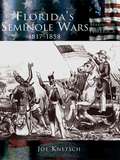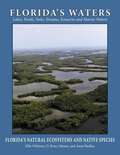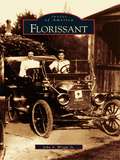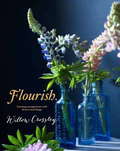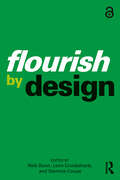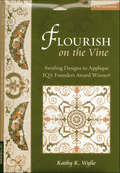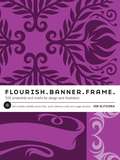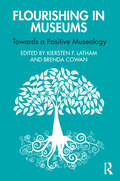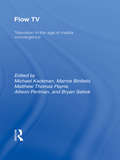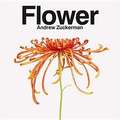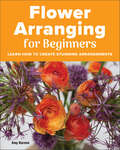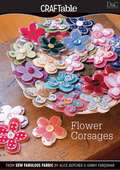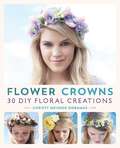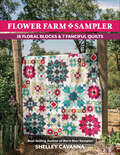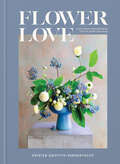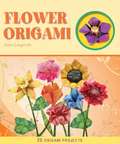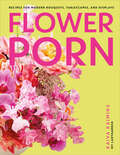- Table View
- List View
Florida's Seminole Wars: 1817-1858 (Making of America)
by Joe KnetschAmong the most well known of Florida's native peoples, the Seminole Indians frustrated troops of militia and volunteer soldiers for decades during the first half of the nineteenth century in the ongoing struggle to keep hold of their ancestral lands. While careers and reputations of American military and political leaders were made and destroyed in the mosquito-infested swamps of Florida's interior, the Seminoles and their allies, including the Miccosukee tribe and many escaped slaves, managed to wage war on their own terms. The study of guerrilla warfare tactics employed by the Seminoles may have aided modern American forces fighting in Viet Nam, Cambodia, and other regions. Years before the first shots of the Civil War were fired, Florida witnessed a clash of wills and ways that prompted three wars unlike any others in America's history, although many of the same policies and mistakes were made in the Indian wars west of the Mississippi.
Florida's Uplands (Florida's Natural Ecosystems and Native Species)
by Ellie Whitney Anne Rudloe D Bruce MeansTaken from the earlier book Priceless Florida (and modified for a stand-alone book), this volume discusses the well-drained areas of Florida, including high pine grasslands, flatwoods and prairies, interior scrub, hardwood hammocks, rocklands and caves, and beach dunes. Introduces readers to the trees and plants, insects, mammals, reptiles, and other species that live in Florida's unique uplands ecosystem.Next in series > >See all of the books in this series
Florida's Waters (Florida's Natural Ecosystems and Native Species)
by Ellie Whitney Anne Rudloe D Bruce MeansTaken from the earlier book Priceless Florida (and modified for a stand-alone book), this volume discusses the fresh- and saltwater systems of Florida, including lakes and ponds; rivers and streams; springs; aquatic caves; estuarine waters and seafloors; submarine meadows, sponge, rock, and reef communities; and the Gulf and Atlantic Ocean. Introduces readers to the trees and plants, insects, mammals, reptiles, and other species that live in Florida's unique water ecosystems, including chicken turtle, barking treefrogs, osprey, herons, bass, crayfish, conchs, cordgrass, and railroad vine. Discusses the food chain and the interconnectedness of all species.See all of the books in this series
Florida's Wetlands (Florida's Natural Ecosystems and Native Species)
by Ellie Whitney Anne Rudloe D Bruce MeansTaken from the earlier book Priceless Florida (and modified for a stand-alone book), this volume discusses Florida's wetlands, including interior wetlands, seepage wetlands, marshes, flowing-water swamps, beaches and marine marshes, and mangrove swamps. Introduces readers to the trees and plants, insects, mammals, reptiles, and other species that live in Florida's unique wetlands ecosystem, including the Virginia iris, American white waterlily, cypress, treefrogs, warblers, and the Florida black bear.Next in series > >See all of the books in this series
Florissant
by John A. Wright Sr.The first civil government in Florissant was established in 1786, three years before the United States adopted its constitution and George Washington was elected the country's first president. French farmers and fur trappers looked upon the land and called it the "Valle Fleurissant"-which is to say, "the flowering or fertile valley." The community remained small until after World War II. Between 1950 and 1980, the population grew from 3,737 to 76,754. Today the community strives to preserve its proud heritage and build on the strength of its diverse population. The historic images in this book illustrate the city's founding and development, from the first French settlers to the post World War II building boom to the exciting new city of today.
Flourish
by Willow CrossleyInspired by wild and wayward floral styles, Willow Crossley creates natural and original arrangements, from cabbage rose to cow-parsley, the book will range from glorious garlands and pretty posies to stunning centrepieces for a banquet or soiree. Flourish demonstrates how easy it is to transform a handful of fresh cuttings into arrangements to decorate your home throughout the year. Arranged by season, Spring covers foxgloves, cowslips and snake head fritillaries, while Summer offers bouquets of roses to rosemary and Autumn includes arrangements of crab apples, chocolate cosmos and clematis flowers. For Winter, Willow draws from ivy, moss and snowberries, whilst also demonstrating how to make an Old Man's Beard- a giant wreath of beautiful white and snow-coloured flowers. This is an original and stylish guide to decorating your home with interesting seasonal blooms and foliage; be it a relaxed lunch table or an elaborate dinner soiree, there is something for every taste and occasion.
Flourish by Design
by Leon Cruickshank Nick Dunn Gemma CoupeFlourish by Design brings together a range of established and emerging voices in design research for a collection that provides original provocations on topics of global significance. It is an insightful guide to original theory and practice concerning how we can design for a better tomorrow. Featuring contributors from a diverse array of backgrounds and professions, this edited book explores the difference that design and design research can make for people, organisations, and the planet to prosper now and in the future. It offers a range of ideas and techniques through practical examples and ongoing projects showing how applied design research can respond to global challenges. Covering topics as diverse as artificial intelligence, bio-inspired materials, more-than-human design, sustainability, and urban acupuncture, it shares interdisciplinary and transdisciplinary design research not just to demonstrate what could be plausible in the near future but also to explain why it might be preferable. By sharing these despatches, this collection represents the very best of what design research can do, explaining how and why. This book is intended for a wide audience of professionals, scholars, and students in design, architecture, and public policy, as well as anyone who has an interest in how we design the world and, in turn, it designs us. The Open Access version of this book, available at www.taylorfrancis.com, has been made available under a Creative Commons Attribution-Non Commercial-No Derivatives (CC-BY-NC-ND) 4.0 license
Flourish on the Vine: Swirling Designs to Appliqué
by Kathy K. WylieNow you can make this award-winning quilt! For this heirloom-quality quilt, the vines and branches were inspired by wrought ironwork, and the bordering swags were imagined from festoons of fruit, as seen in Roman Empire temples. You can make the quilt as shown, or mix and match the elements to create your own design. Kathy gives you plenty of preparation guidelines to ensure success, whether you use her needle-turn method or choose a different appliqué technique. • This graceful and sophisticated quilt is divided into twelve sections, making it easier to complete • Luxurious, intricate details offer a challenge for experienced quilters, and comprehensive instructions with template tips make it approachable for ambitious beginners • Full-size pattern sheets are included for this quilt inspired by the bible verse, "I am the vine, you are the branches..." —John 15:5
Flourish. Banner. Frame.
by Von GlitschkaROYALTY-FREE ORNAMENTS INCLUDED ON DVD FOR YOUR USE! Ornaments and motifs add something special to creative projects, but not all creatives can devote the hundreds of hours necessary to developing them. Flourish. Banner. Frame. is an amazing library of 555 original symbols, floral motifs, border treatments, frills, banners, shields, crests, ornaments, decorative frames, placards and cartouches. Each design element has been crafted with vector precision, and you can use this artwork within the context of your own projects, whether they are personal or professional in nature. There are 10 real-life examples in the book, so you can be inspired by top designers and illustrators. This extensive volume of ornaments and motifs is easy to use for any design or illustration project: publication layouts, book covers, website backgrounds, t-shirt graphics, scrapbooks, textiles, crafts, stencils, tattoos-and everything in between. Whether you are a beginner or an advanced design professional, you'll turn to this resource again and again for years to come.
Flourish. Banner. Frame.: 615 Ornaments and Motifs for Design and Illustration
by Glitschka VonOrnaments and motifs add something special to creative projects, but not all creatives can devote the hundreds of hours necessary to developing them. Flourish. Banner. Frame. is an amazing library of 555 original symbols, floral motifs, border treatments, frills, banners, shields, crests, ornaments, decorative frames, placards and cartouches. Each design element has been crafted with vector precision, and you can use this artwork within the context of your own projects, whether they are personal or professional in nature.There are 10 real-life examples in the book, so you can be inspired by top designers and illustrators. This extensive volume of ornaments and motifs is easy to use for any design or illustration project: publication layouts, book covers, website backgrounds, t-shirt graphics, scrapbooks, textiles, crafts, stencils, tattoos-and everything in between. Whether you are a beginner or an advanced design professional, you’ll turn to this resource again and again for years to come.Royalty-free ornaments included on DVD for your use!
Flourish. Banner. Frame.
by Von GlitschkaROYALTY-FREE ORNAMENTS INCLUDED ON DVD FOR YOUR USE! Ornaments and motifs add something special to creative projects, but not all creatives can devote the hundreds of hours necessary to developing them. Flourish. Banner. Frame. Is an amazing library of 555 original symbols, floral motifs, border treatments, frills, banners, shields, crests, ornaments, decorative frames, placards and cartouches. Each design element has been crafted with vector precision, and you can use this artwork within the context of your own projects, whether they are personal or professional in nature. There are 10 real-life examples in the book, So you can be inspired by top designers and illustrators. This extensive volume of ornaments and motifs is easy to use for any design or illustration project: publication layouts, book covers, website backgrounds, t-shirt graphics, scrapbooks, textiles, crafts, stencils, tattoos-and everything in between. Whether you are a beginner or an advanced design professional, you'll turn to this resource again and again for years to come.
Flourish: Stunning Arrangements With Flowers And Foliage For Every Season
by Willow CrossleyInspired by wild and wayward floral styles, Willow Crossley creates natural and original arrangements, from cabbage rose to cow-parsley, the book will range from glorious garlands and pretty posies to stunning centrepieces for a banquet or soiree. Flourish demonstrates how easy it is to transform a handful of fresh cuttings into arrangements to decorate your home throughout the year. Arranged by season, Spring covers foxgloves, cowslips and snake head fritillaries, while Summer offers bouquets of roses to rosemary and Autumn includes arrangements of crab apples, chocolate cosmos and clematis flowers. For Winter, Willow draws from ivy, moss and snowberries, whilst also demonstrating how to make an Old Man's Beard- a giant wreath of beautiful white and snow-coloured flowers. This is an original and stylish guide to decorating your home with interesting seasonal blooms and foliage; be it a relaxed lunch table or an elaborate dinner soiree, there is something for every taste and occasion.
Flourishing in Museums: Towards a Positive Museology
by Brenda Cowan Kiersten F. LathamFlourishing in Museums presents the Flourishing Museum Framework, an interdisciplinary model for reflection and practice. Illustrated via a diversity of international examples, the framework demonstrates how museums can meaningfully address the many challenges facing the profession. Including contributions from a wide range of scholar-practitioners working across the arts, humanities, sciences, education, business, and mental health disciplines, the volume uses abundance-thinking and takes a strengths-based appreciative approach to museum purpose, function, and being. The book demonstrates that, even within the most difficult climates, abundance-oriented methods and perspectives can inspire and elicit flourishing in visitors, staff, and communities, thus positioning museums as places where people find meaningful and purposeful work and where visitors find satisfaction, meaning, inspiration, and motivation. Drawing from the disciplines of positive psychology, positive organizational scholarship, contemplative studies, and museum studies, the book is unified and organized into six thematic areas that comprise the Flourishing Museum Framework: courage, transformation, care, optimism, gratitude, and delight. Flourishing in Museums will be essential reading for academics and students working in the museum and heritage fields, as well as the cognate disciplines of arts management and creative industries. It will also be useful to practitioners working in museums and heritage sites around the world.
Flourishing in Museums: Towards a Positive Museology
by Brenda Cowan Kiersten F. LathamThis book Includes contributions from a wide range of scholar-practitioners working across the arts, humanities, sciences, education, business, and mental health disciplines. Uses abundance-thinking and takes a strengths-based appreciative approach to museum purpose, function and being. Demonstrates that, even within the most difficult climates, abundance-oriented methods and perspectives can inspire and elicit flourishing in visitors, staff and communities, thus positioning museums as places where people find meaningful and purposeful work and where visitors find satisfaction, meaning, inspiration, and motivation. Draws from the disciplines of positive psychology, positive organizational scholarship, contemplative studies, and museum studies, the book is unified and organized into six thematic areas that comprise the Flourishing Museum Framework: courage, transformation, care, optimism, gratitude, and delight. Will be essential reading for academics and students working in the museum and heritage fields, as well as the cognate disciplines of arts management and creative industries. It will also be useful to practitioners working in museums and heritage sites around the world.
Flow TV: Television in the Age of Media Convergence
by Michael KackmanFrom viral videos on YouTube to mobile television on smartphones and beyond, TV has overflowed its boundaries. If Raymond Williams' concept of flow challenges the idea of a discrete television text, then convergence destabilizes the notion of television as a discrete object. Flow TV examines television in an age of technological, economic, and cultural convergence. Seeking to frame a new set of concerns for television studies in the 21st century, this collection of all new essays establishes television’s continued importance in a shifting media culture. Considering television and new media not as solely technical devices, but also as social technologies, the essays in this anthology insist that we turn our attention to the social, political, and cultural practices that surround and inform those devices' use. The contributors examine television through a range of critical approaches from formal and industrial analysis to critical technology studies, reception studies, political economy, and critiques of television's transnational flows. This volume grows out of the critical community formed around the popular online journal Flow: A Critical Form on Television and Media Culture (flowtv.org). It is ideal for courses in television studies or media convergence.
Flower
by Andrew ZuckermanIn this collection, Andrew Zuckerman, beloved photographer of Creature and Bird, moves from fauna to flora, turning his lens onto the most beautiful specimens of the plant kingdom. Spectacular close-up images of 150 flower species, both exotic and familiar, are lovingly captured in Zuckerman's bold yet sensitive signature style. Showcased against pure white backgrounds, the complexity of color and structure in each specimen is revealed--creating flower portraits of astonishing radiance and detail. Zuckerman's award-winning minimalism serves as the perfect foil for these lush natural wonders. A rich visual tour of nature's most beloved beauties, this substantial tome is a timeless treasure for flower lovers, garden enthusiasts, photography buffs, and collectors of Zuckerman's work.
Flower Arranging for Beginners: Learn How to Create Stunning Arrangements
by Amy BareneYour ultimate guide to building beautiful bouquetsFlowers are a gorgeous gift from nature! They can boost your mood or brighten a room—and custom flower arrangements are an amazing way to express yourself as you bring the beauty of the outdoors in. With this beginner's guide to flower arranging, you'll discover the secrets to matching colors and styles and creating a cohesive aesthetic that transforms your favorite flowers into stunning centerpieces. Gather your materials —Discover what it takes to assemble a healthy bouquet, from assessing and preparing flowers to the right tools, and choosing a vase or vessel. Explore floral design —Learn about the artistic elements that help create eye-catching arrangements, like color scheme, texture, harmony, and scale. Get ready to arrange —Experiment with 25 classic and contemporary arrangements that feature vivid illustrations and simple, step-by-step instructions to ensure success. Liven up your space with this beginner-friendly flowering arranging book .
Flower Class Corvettes (Shipcraft Ser.)
by John Lambert Les BrownA guide to creating models of the World War II warship, featuring history on the ship as well as crafting tips. The &“ShipCraft&” series provides in-depth information about building and modifying model kits of famous warship types. Lavishly illustrated, each book takes the modeler through a brief history of the subject class, highlighting differences between sister-ships and changes in their appearance over their careers. This includes paint schemes and camouflage, featuring color profiles, highly detailed line drawings, and scale plans. The modelling section reviews the strengths and weaknesses of available kits, lists commercial accessory sets for super-detailing of the ships, and provides hints on modifying and improving the basic kit. This is followed by an extensive photographic gallery of selected high-quality models in a variety of scales, and the book concludes with a section on research references—books, monographs, large-scale plans and relevant websites. This volume includes all the features of the regular series, but the extent has been doubled to include far more detailed drawings of a class of ship that was built in huge numbers and in many variations. Mainstay of the Atlantic battle against the U-boats, Flower class corvettes were used by the British, Canadian, French, and U.S. Navies.&“An excellent guide to an important ship in the Second World War, for modeler and maritime enthusiasts alike.&” —The Nautical Magazine
Flower Corsages
by Alice Butcher Ginny FarquharThese flower corsages are a novel and attractive way to make use of your favourite fabric scraps. Colourwise, the sky is the limit. From pretty florals and funky retros to winter wools and velvets, you could make a corsage to coordinate with every outfit. Thesecorsages look fantastic pinned on to a jacket, but they could also jazz up a hat or a bag. Have fun embellishing with buttons, beadsor stitch details to create a huge variety of different effects!
Flower Crowns: 30 Enchanting DIY Floral Creations
by Christy Meisner DoramusTHE FIRST GUIDE SHOWING YOU HOW TO CRAFT THESE WILDLY POPULAR, WHIMSICAL, AND GLAMOROUS HAIR ACCESSORIES AT HOME Whether you’re at a wedding, going out on the town or partying at a musical festival, the flower crowns in this book will make your outfit standout for any occasion. With step-by-step instructions and photos, tips for choosing flowers and hints on color combinations, this is the ultimate guide to creating gorgeous crowns, including: ROSEBUD & DAISY GREEK GODDESS LEAVES & LAVENDER HARVEST PINK PEONY FRESH SUNFLOWER SUMMER CONCERT WILDFLOWER TULIP & DELPHINIUM MARDI GRAS FAUX FLOWER BLUSHING BRIDE HAIRPIECE
Flower Farm Sampler: 18 Floral Blocks & 7 Fanciful Quilts
by Shelley CavannaCreate a floral and starry sampler quilt that’s as refreshing as a spring breeze! Step into a garden of creativity with best-selling author Shelley Cavanna’s new book! Bursting with vibrant spring and summertime blooms, Flower Farm Sampler invites you to explore 18 unique blocks that can be combined into a full sampler or seven other captivating quilt projects. From petite 4” blocks to eye-catching 24” blocks, these designs come together as fresh, vibrant pieces that breathe life into any room. With so many block sizes and designs, fabric possibilities, and easy-to-follow quilt layouts, this collection will provide endless inspiration and instruction for beautiful floral and blooming projects. Embark on a fresh quilting adventure with Shelley Cavanna, author of the best-selling Barn Star Sampler Create the full sampler from 18 floral-inspired blocks, or make one of seven other blossoming quilts, all with the vibrant hues of a flower farm Engages and inspires fans of her first book with the same beloved techniques and inspirations while creating a whole new suite of on-trend and stunning projects
Flower Love: Lush Floral Arrangements for the Heart and Home
by Kristen Griffith-VanderYachtA playful, approachable guide to a rainbow of flower arrangements from the expert floral designer and host of Netflix&’s The Big Flower Fight.Whether you are new to floristry or have been at it long enough to see carnations come in and out of fashion more times than the mullet, it&’s easy to fall in love and stay in love with flowers. For Kristen Griffith-VanderYacht, flowers are everything—reminders of nature&’s beauty, tools for building creative confidence, and a gateway to self-care.In Flower Love, Griffith-VanderYacht uses his effervescent sense of humor and sharp eye for design to bring accessible, sumptuous floral arrangements to flower lovers everywhere, from all walks of life. With stunning photography of forty-five arrangements, visual step-by-step instructions, and a unique, geometric approach to floral design, Flower Love is an empowering and joyful resource for anyone who wants to add fanciful floral whimsy to their everyday life.This book includes:• Step-by-step instructions for forty-five stunning floral arrangements• The Ten Floral Commandments• The elements of foolproof floral design• Helpful design hacks you won't find anywhere else• A detailed flower glossary organized by color and seasonLearn to source and style lush floral arrangements with this primer on design. All you need are some flowers, scissors, and an appreciation for our planet&’s ubiquitous natural beauty. So, pop on your favorite tunes and give yourself some Flower Love.
Flower Origami (Origami Books)
by Joost LangeveldFold your way to fabulous flowers!Fold your way to fabulous flowers! Bringing flowers into your home can make it brighter and more beautiful, and Flower Origami teaches you how to turn a flat sheet of paper into a flower. Whether your favorites are dahlias or azaleas, daffodils or sunflowers, you'll find simple instructions for crafting them in your own home. Use this traditional Japanese art to make elegant bluebells, pink anthuriums, and bright yellow narcissus that will look just like the real thing. With Flower Origami, your folding skills will grow by leaps and bounds—just like a flower!
Flower Porn
by Kaiva KaiminsFresh, artistic and cheeky designs for a new generation of creative florists.Bold, modern and more than a little bit cheeky, Flower Porn ditches the traditional floral bouquets for designer arrangements that you can recreate at home. Kai Kaimins, founder of East London florist My Lady Garden, shows you how to fill your home or office with eye-catching, Instagram-worthy arrangements.By following her flower recipes, you&’ll unlock the secrets of color theory and get up close and personal with a huge array of blooms, season by season. Complete with an essential chapter on floristry techniques, this book will show you how to choose the best flowers for each arrangement, and prepare each stem to make sure that your bold creations will last.Float into the pages of this flirty flower book to explore: - Four chapters of flower arrangements are arranged by season, with each project presented as a recipe, complete with a food-related heading.- A preliminary chapter will cover the key techniques and processes readers will need to create each flower recipe.- Featuring vivid photography and modern layouts that capture Kai&’s style and the My Lady Garden aesthetic.There&’s nothing quite like a bouquet of flowers, and there is absolutely nothing at all like the bouquets, arrangements and stunning displays in Flower Porn to bring beauty to a room.A must-have addition to the library of every flower-arranger - whether you&’re discovering the art form for the first time, or already a professional florist looking for new ideas for the business, Flower Porn has something for everyone to love. n to bring beauty to a room.
Flower School: A Practical Guide to the Art of Flower Arranging
by Calvert CraryCreate the flower arrangements of your dreams to keep at home, take to the office, or display on any special occasion using the simple tips and tricks and masterful techniques taught by Executive Director and professor Calvert Crary and the master florists at FlowerSchool New York.FlowerSchool New York is one of the world's premiere institutes for floral design and artistry, offering career development courses certified by the New York State Board of Education, and exclusive master class programs taught by celebrated master florists including Kiana Underwood, Remco Van Vliet, Lewis Miller, Emily Thompson, and Ingrid Carozzi. Now, for the first time, FlowerSchool Executive Director Calvert Crary is publishing a book that will make it possible for even the greenest at-home arrangers to create gorgeous, Instagram worthy bouquets. This hands-on, comprehensive guide provides readers with step-by-step instructions that cover all the most crucial aspects of flower arranging, including:How to buy the best flowers and how to get the best pricesSelecting your flowers based on texture, color, and seasonalityConditioning your flowers to ensure they last as long as possiblePairing your flowers with the right vaseCreating arrangements in a wide variety of styles that will work for any occasionIncluding advice from the school's well-respected master florists, and featuring beautiful color photographs of each unique arrangement, Flower School offers invaluable, insider tips and tricks that can only be gained through years of experience, providing readers with the fundamental tools and education they need to create homemade floral arrangements that are on par with any professional design.
